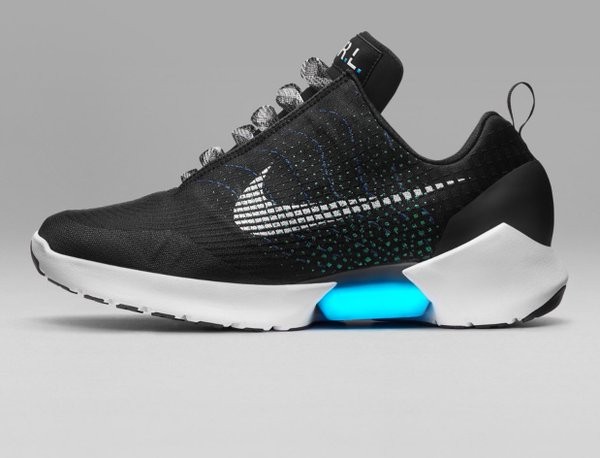Nike's self-lacing sneakers inspired by Marty McFly riding a hoverboard in the 1989 movie "Back to the Future II" will be available on November 28 or "Cyber Monday." The sports shoe giant announced that HyperAdapt 1.0 will hit the retail market through some Nike retail locations in the United States. Pricing for the futuristic shoes have not been released although they will reportedly have a high price tag.
The Nike shoes are made using a special process. A fishing line and pressure sensor in the lightweight shoe's sole form the sneaker's internal cable system.
After a person puts on the Nike shoe an "algorithmic pressure equation" causes the cables to tighten. Two buttons near the sneaker's tongue allow the wearer to make the fit tighter or looser.
The laces do not authentically tie up. Instead the shoe works more like a snow boot tightening or automatic buckling.
LEDs contained in the footwear's heel light up when the sneakers are tightening. They also glow when the sports shoe is low battery and has to be charged.
The bottom of the shoe connects to a wireless charging pod. A full charge of the shoes takes three hours and lasts around two weeks. Nike will bundle a magnetic clip-on charger like the one from Apple for the Apple Watch, according to The Verge.
The self-lacing shoes can benefit athletes since they could quickly tie up their shoes before a race, or in the middle of a game or match.
The shoes inspired by the film that starred Michael J. Fox and featured a DeLorean car/time machine has been in the works for years. In the movie crewmembers under a platform pulled wires to manually tighten the laces. Nike auctioned off a non-working pair in 2011.
Last October a Nike designer sent Fox a working prototype of the shoes. Then in March 2016 the shoe company announced a retail version known as HyperAdapt that was developed for mass market.
In related news, a New York-based startup has created "Pokémon Go" smart shoes that include sensors and LED displays, according to Digital Spy. A mobile app operates the Internet of Things (IoT) footwear and allows gamers to control which images show up on the shoes' panel.
The smart shoes' sensors provide app functions such as notifications about location. In addition, the high-tech sneakers are water-resistant, and a full charge provides eight hours of pocket monster-hunting.



























